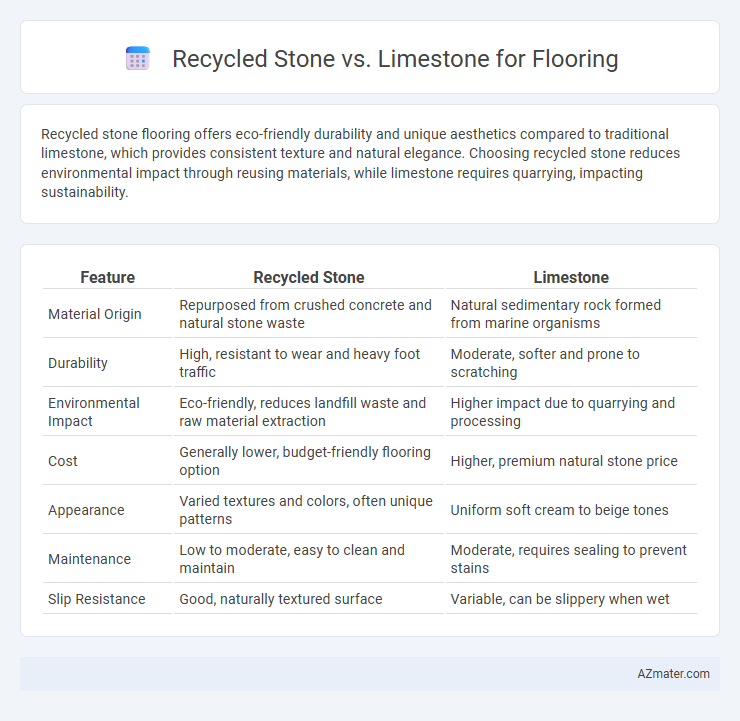Recycled stone flooring offers eco-friendly durability and unique aesthetics compared to traditional limestone, which provides consistent texture and natural elegance. Choosing recycled stone reduces environmental impact through reusing materials, while limestone requires quarrying, impacting sustainability.
Table of Comparison
| Feature | Recycled Stone | Limestone |
|---|---|---|
| Material Origin | Repurposed from crushed concrete and natural stone waste | Natural sedimentary rock formed from marine organisms |
| Durability | High, resistant to wear and heavy foot traffic | Moderate, softer and prone to scratching |
| Environmental Impact | Eco-friendly, reduces landfill waste and raw material extraction | Higher impact due to quarrying and processing |
| Cost | Generally lower, budget-friendly flooring option | Higher, premium natural stone price |
| Appearance | Varied textures and colors, often unique patterns | Uniform soft cream to beige tones |
| Maintenance | Low to moderate, easy to clean and maintain | Moderate, requires sealing to prevent stains |
| Slip Resistance | Good, naturally textured surface | Variable, can be slippery when wet |
Introduction: Why Choose Sustainable Flooring Materials?
Sustainable flooring materials such as recycled stone and limestone offer eco-friendly alternatives by minimizing environmental impact and conserving natural resources. Recycled stone floors reduce waste by repurposing materials from construction debris, while limestone provides a durable, long-lasting option sourced from natural deposits with low processing energy. Both choices contribute to healthier indoor air quality and support green building certifications like LEED.
Understanding Recycled Stone Flooring
Recycled stone flooring offers an eco-friendly alternative by repurposing natural stone fragments, reducing waste and environmental impact compared to traditional limestone flooring. It provides comparable durability and aesthetic appeal, with unique patterns and textures that enhance sustainability in interior design. Understanding the benefits of recycled stone flooring emphasizes its role in green building practices and material conservation.
Overview of Limestone Flooring
Limestone flooring offers a natural, durable option with its sedimentary rock composition primarily of calcium carbonate, providing a smooth, matte finish suitable for both indoor and outdoor spaces. Its porous nature requires regular sealing to prevent stains and moisture damage, making maintenance a key consideration compared to recycled stone options. Limestone's aesthetic appeal lies in its subtle earthy tones and unique fossil patterns, highlighting its organic origin and timeless elegance.
Environmental Impact: Recycled Stone vs. Limestone
Recycled stone flooring significantly reduces environmental impact by repurposing existing materials, minimizing quarrying and lowering carbon emissions compared to limestone extraction. Limestone flooring requires extensive mining, contributing to habitat disruption, dust pollution, and higher energy consumption during processing. Choosing recycled stone supports sustainable construction practices by conserving natural resources and reducing landfill waste.
Durability and Longevity Comparison
Recycled stone flooring offers high durability by repurposing materials like concrete and granite, providing resistance to wear and environmental stress comparable to natural stone. Limestone flooring, while aesthetically appealing and softer underfoot, is more susceptible to scratches, stains, and acid damage, reducing its longevity in high-traffic areas. For long-lasting flooring solutions, recycled stone generally outperforms limestone in terms of durability and lifespan, making it a practical choice for both residential and commercial spaces.
Aesthetic Differences Between Recycled Stone and Limestone
Recycled stone flooring often features a unique, variegated appearance with a mix of colors and textures that result from repurposed materials, providing a rustic and distinctive aesthetic. Limestone flooring, in contrast, offers a more uniform and natural look with soft, earthy tones and subtle veining, creating an elegant and timeless appeal. The choice between recycled stone and limestone influences the overall design style, from contemporary eclectic to classic sophistication.
Installation Process: Recycled Stone vs. Limestone
Recycled stone flooring often features smaller, irregular pieces that require more careful arrangement and sometimes custom fitting during the installation process, resulting in longer labor times compared to limestone. Limestone tiles are typically uniform in size and shape, allowing for straightforward installation with standard adhesive and grout techniques, which can reduce overall project duration. Both materials demand a sealed finish to protect against moisture and stains, but recycled stone may require additional surface preparation to ensure durability and adherence.
Maintenance and Care Requirements
Recycled stone flooring requires minimal maintenance, as it resists staining and does not need frequent sealing, making it a cost-effective and eco-friendly choice. Limestone flooring, while visually appealing, demands regular sealing and more cautious cleaning to prevent etching and damage from acidic substances. Proper care for limestone involves gentle cleaning agents and periodic resealing to maintain its durability and aesthetic appeal over time.
Cost Analysis: Initial Investment and Long-Term Value
Recycled stone flooring typically offers a lower initial investment compared to natural limestone due to its use of repurposed materials and reduced quarrying expenses. Limestone flooring, while more expensive upfront, provides superior durability and longevity, potentially lowering maintenance costs and increasing resale value over time. Considering long-term value, limestone's natural hardness and resistance to wear often justify the higher initial cost through extended lifespan and sustained aesthetic appeal.
Conclusion: Which Flooring Option Is Right for You?
Recycled stone flooring offers an eco-friendly, cost-effective alternative with unique aesthetic appeal, while limestone provides timeless elegance and durability with a natural, smooth finish. Choosing between the two depends on your priorities: sustainability and budget favor recycled stone, whereas classic beauty and long-lasting performance favor limestone. Consider factors such as environmental impact, maintenance requirements, and design style to determine the best flooring option for your space.

Infographic: Recycled stone vs Limestone for Flooring
 azmater.com
azmater.com